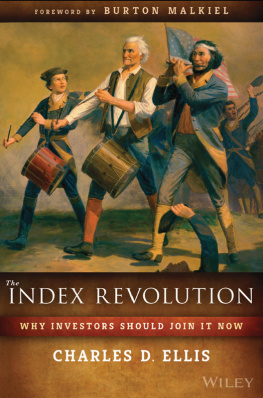The End of Indexing
Six structural mega-trends that will threaten passive investing
Niels Jensen
Harriman house
HARRIMAN HOUSE LTD
18 College Street
Petersfield
Hampshire
GU31 4AD
GREAT BRITAIN
Tel: +44 (0)1730 233870
Email: enquiries@harriman-house.com
Website: www.harriman-house.com
First published in Great Britain in 2018
Copyright Niels Jensen
The right of Niels Jensen to be identified as the author has been asserted in accordance with the Copyright, Design and Patents Act 1988.
Hardback ISBN: 978-0-85719-549-4
eBook ISBN: 978-0-85719-550-0
British Library Cataloguing in Publication Data
A CIP catalogue record for this book can be obtained from the British Library.
All rights reserved; no part of this publication may be reproduced, stored in a retrieval system, or transmitted in any form or by any means, electronic, mechanical, photocopying, recording, or otherwise without the prior written permission of the Publisher. This book may not be lent, resold, hired out or otherwise disposed of by way of trade in any form of binding or cover other than that in which it is published without the prior written consent of the Publisher.
Whilst every effort has been made to ensure that information in this book is accurate, no liability can be accepted for any loss incurred in any way whatsoever by any person relying solely on the information contained herein.
No responsibility for loss occasioned to any person or corporate body acting or refraining to act as a result of reading material in this book can be accepted by the Publisher, by the Author, or by the employers of the Author.
This book is dedicated to my extraordinary wife.
Contents
Praise for The End of Indexing
The investment world is changing. The lessons learned in the stupendous global bull market of the last 40 years will serve us very poorly in the years ahead. With The End of Indexing, Niels Jensen offers a perfect primer for those seeking to understand the structural market trends and their impact on investment. This book is a treasure trove of market insights, presented in a global context, that will help readers navigate the coming headwinds and reach their goals in this brave new investment world.
Rob Arnott, founder and CEO, Research Affiliates
Niels Jensen is particularly well versed in not only the trends of the markets, but how to take advantage of them. I have worked closely with Niels for over 15 years and I rank him as one of the most astute investors I know. His book, The End of Indexing, it is not only a remarkable study of market trends and economic reasoning, it is done with his inimitable style and grace in writing that makes everything he writes so readable and immediately come to the front of my reading list when it shows up in my inbox. This is a book youre going to want to read more than once. And every time you do you will learn something new and important.
John Mauldin, five times bestselling author and chairman, Mauldin Economics.
So often, it seems that analysts and investors are aware of important long-term issues but choose to discount them, and focus instead on short-term ones, that seem more concrete retaining only a vague sense of concern that they might be missing something. Keynes taught us the dangers of being myopic. So, for example, it is important to consider both short-term momentum and long-term value when investing: they are, as it were, two sides of the same coin. Niels book, and the approach he takes to separating out key long-term structural issues and hammering home their importance, may help to redress the balance. And it may well help a number of investors to improve upon their own approaches.
Sushil Wadhwani, Founder of Wadhwani Asset Management
About the Author
Niels Jensen has over 30 years of investment banking and investment management experience. He began his career in Copenhagen in 1984 before moving to London in 1986. He founded Absolute Return Partners in 2002 and, today, he is the Chief Investment Officer of the firm. In 2006 he was appointed Director of a leading UK corporate pension fund, advising it on its investment strategy a position he continues to hold.
Acknowledgements
First and foremost, I should thank my publisher, Harriman House. After having read some of my work, Craig Pearce contacted me one day in early 2016, suggesting that I could quite possibly write a book that wouldnt put everyone to sleep.
Up until that point, I had never given any serious consideration to the idea of writing a book and, at first, I was disinclined to accept the invitation I simply had too many things on the agenda already. However, one thing led to another, and here we are. It has been quite a phenomenal experience, one that I have thoroughly enjoyed. Craig and Stephen thank you for all the support you have provided throughout this journey.
When you write a book in a language that is not your first language, you are bound to make the occasional howler. My problem, after having lived in the UK for more than 30 years, is that I have no first language anymore. My English has never been perfect, and my Danish is deteriorating by the day particularly my written Danish, which I rarely use anymore.
Despite some great work conducted by my primary editing team, Alison Major Lpine and Tom Duggan, a gaffe or two may still have found its way in to the manuscript, and all I can ask for is your forgiveness. Talking about working colleagues, not mentioning Shameek Patel would be almost criminal. Shameek is the artistic director of this book; he has converted all the underlying data into a series of great charts. Thank you to all of you.
I like charts they often tell more than a thousand words and the charts I have chosen for this book form an integral part of the story I want to tell. As most of my charts have been borrowed from various external sources, I can honestly say that this book would never have happened if it wasnt for the generosity shown by the people who have kindly allowed me access to their work.
Having said that, I ought to mention that not everyone I approached allowed me to use their work. Shame, but it only re-emphasises how much I appreciate the cooperation of those who did. Thank you so much!
As far as research is concerned, two sources stand out. Woody Brock from Strategic Economic Decisions () has been a wealth of information in the preparation of this book. Woody doesnt pay much attention to the short term. He thinks there is far too much noise in most short-term data to draw any reliable conclusions from, which is one of the reasons I have always enjoyed working with him. Nobody provides a better long-term picture than he does. Thank you so much for allowing me to use much of your work, Woody.
Secondly, more recently I have started to work with a UK research boutique called MacroStrategy Partnership LLP ( www.macrostrategy.co.uk ). Like Woody, the approach to research in that firm is quite strategic in nature. They dont care much and neither do I why retail sales came in a bit below expectations last month. Instead, they focus on longer-term trends an approach to economic research that I wholeheartedly subscribe to.
The whole team at MacroStrategy Partnership have been tremendously helpful when I put this book together; however, Andy Lees deserves a special mention. He has gone out of his way to help me. He has read and edited entire chapters, and his help and assistance has been nothing short of marvellous.
For example, as I wrote the passages on fusion energy in chapters 7 and 10, I very quickly realised that I was in the deep end of the pool, but Andys expert knowledge and guidance kept me afloat. All I can offer in return is a massive Thank You.
Other people have bent over backwards in their desire to help me, but this book would probably be at least 100 pages longer, if each and every one was going to get a mention. All I can say is that your fabulous help hasnt gone unnoticed just because you havent been mentioned on these pages.
Next page





